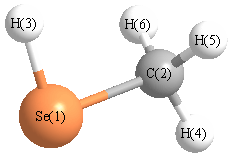|
|
II.B.6. |
Experimental Barriers to Internal Rotation for CH3SeH (Methane selenol)
Data from:1973Tho:70
CH Thomas "Microwave spectrum, barrier to internal rotation, structure, and dipole moment of methane selenol" J. Chem. Phys. 59(1), 70, 1973
| torsion index | Angle | Energy (kJ mol-1) | Energy (cm-1) |
|---|---|---|---|
| 1 | 0 | 4.19 | 350 |
| 1 | 15 | 3.57 | 299 |
| 1 | 30 | 2.09 | 175 |
| 1 | 45 | 0.61 | 51 |
| 1 | 60 | 0.00 | 0 |
| 1 | 75 | 0.61 | 51 |
| 1 | 90 | 2.09 | 175 |
| 1 | 105 | 3.57 | 299 |
| 1 | 120 | 4.19 | 350 |
| 1 | 135 | 3.57 | 299 |
| 1 | 150 | 2.09 | 175 |
| 1 | 165 | 0.61 | 51 |
| 1 | 180 | 0.00 | 0 |
| 1 | 195 | 0.61 | 51 |
| 1 | 210 | 2.09 | 175 |
| 1 | 225 | 3.57 | 299 |
| 1 | 240 | 4.19 | 350 |
| 1 | 255 | 3.57 | 299 |
| 1 | 270 | 2.09 | 175 |
| 1 | 285 | 0.61 | 51 |
| 1 | 300 | 0.00 | 0 |
| 1 | 315 | 0.61 | 51 |
| 1 | 330 | 2.09 | 175 |
| 1 | 345 | 3.57 | 299 |
| 1 | 360 | 4.19 | 350 |
Atoms in torsion 1 are 3, 1, 2, 4
The rotor type is SeH

Got a better number? Please email us at
cccbdb@nist.gov